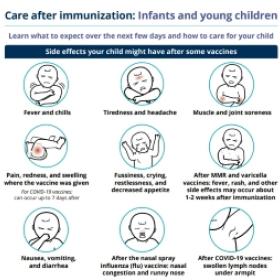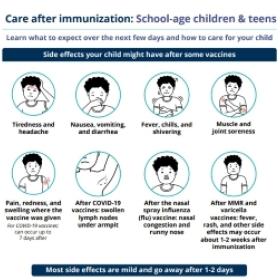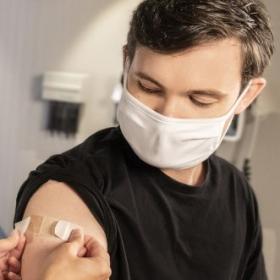On March 31, the ImmunizeBC website will move over to HealthLinkBC.ca After this date, you will be automatically redirected to HealthLink BC’s Immunization landing page. HealthLink BC provides trusted health information online and over the phone 24 hours a day, seven days a week by calling 8-1-1.
Date last reviewed:
Monday, Oct 21, 2024
HealthLinkBC
Available in 简体中文 (Simplified Chinese), 繁體中文 (Traditional Chinese), یسراف (Farsi), 한국어 (Korean), ਪੰਜਾਬੀ (Punjabi), and other languages.

Diseases it protects against
The MMRV vaccine protects against:
- Measles.
- Mumps.
- Rubella.
- Varicella, also known as chickenpox.
These diseases can cause serious illness, hospitalization, and even death. Learn more about these diseases.
Fact
Did you know?
Measles is so contagious that if one person has it, 9 out of 10 people around them will also become infected if they are not protected.
Who should get the vaccine
| Age | Schedule |
|---|---|
| Young children |
|
| School-age children |
|
Information
Chickenpox can be serious
Chickenpox is usually a mild disease. But in some cases, it can cause serious problems, such as pneumonia (lung infection), encephalitis (swelling of the brain), and bacterial infections of the skin. It doesn’t happen often, but people can die from chickenpox.
Safety
Vaccine safety is a top priority in Canada. Every vaccine must be shown to be safe and effective before it is approved for use in Canada. After approval, the safety of vaccines is continuously monitored. Learn more about vaccine safety.
Fact
Vaccines are very safe.
Getting the vaccine is much safer than getting one of the diseases.
Side effects
Often, vaccines cause no side effects, but sometimes they do. When side effects happen, they are usually mild and last 1 to 2 days. Serious side effects are very rare.
Common reactions to the MMRV vaccine may include:
-
Soreness, redness and swelling where the vaccine was given.
-
Mild fever, swelling in the cheeks or neck, and a rash that looks like measles, rubella or chickenpox may occur about 1 to 2 weeks after the vaccine.
Very rarely, a person who develops a chickenpox-like rash after being immunized can spread the virus from the vaccine. To prevent spreading it to others, cover the rash until the blisters have dried and crusted over.
More serious reactions may include a temporary drop in the blood cells that help prevent bleeding (about 1 child in 30,000) and encephalitis, an inflammation of the brain (about 1 child in 1 million). The possibility of getting encephalitis from measles, about 1 in 1,000, is much higher than from the vaccine. The risks of serious reactions following the MMRV vaccine have not been established. They may be similar to the MMR vaccine risks listed above.
It is important to stay at the clinic for 15 minutes after your vaccine. Some people may have a rare but serious allergic reaction called anaphylaxis. If anaphylaxis happens, you will get medicine to treat the symptoms.
Let your immunization provider/clinic or health care provider know if you or your child have any serious or unexpected side effects after immunization.
How to manage side effects
For information on how to manage side effects, view the immunization aftercare sheets below.
Who should not get the vaccine
Speak with your health care provider if your child:
- Had a life-threatening reaction to a previous dose of a measles, mumps, rubella or varicella vaccine or any part of the MMRV vaccine including neomycin and gelatin.
- Has an immune system weakened by disease or medical treatment.
- Had a blood transfusion or received other blood products within the past 12 months.
- Had a drop in platelets, the blood cells that help prevent bleeding, after getting a previous dose of MMR or MMRV vaccine without another cause being identified.
- Has active untreated tuberculosis.
- Is pregnant or planning to become pregnant. People should avoid becoming pregnant for 1 month after getting the vaccine.
There is no need to delay getting immunized because of a cold or other mild illness. However, if you have concerns, speak with your health care provider.
Disease quick facts
- Measles
-
What is measles?
Measles is a serious illness caused by the measles virus. Measles is very contagious.Because of immunization, measles is now a rare disease in Canada. Most cases occur in unimmunized people, including visitors to Canada who have traveled overseas.How does it spread?
Measles is very contagious and spreads easily. The virus spreads through the air when an infected person breathes, coughs, or sneezes. The measles virus can survive in small droplets in the air for several hours. You can become infected when you breathe in these droplets or touch objects contaminated with the virus. The airborne spread of the measles virus makes the disease very contagious. Sharing food, drinks or cigarettes, or kissing someone who has the virus can also put you at risk.What are the symptoms?
Symptoms of measles include fever, cough, runny nose, and red and inflamed eyes that are often sensitive to light. These symptoms are followed by a rash, which starts first on the face and neck and spreads to the chest, arms and legs. The rash lasts about 4 to 7 days. There may also be small white spots inside the mouth. Symptoms can start as soon as 7 days after a person is infected with the measles virus.What are the risks of the disease?
Measles can cause encephalitis, an inflammation of the brain, which can lead to seizures, deafness, or brain damage. One out of every 3,000 people with measles may die from complications. Complications and death are most common in infants less than 12 months of age and adults.Complications of measles can include:- Ear infections
- Diarrhea
- Pneumonia
- Encephalitis (1 in every 1,000 cases)
- Mumps
-
What is mumps?
Mumps is a disease caused by the mumps virus. Mumps was a common childhood disease before immunization. It is now more common in young adults.How does it spread?
Mumps is very contagious and spreads easily. Mumps is spread by contact with saliva or mucus from an infected person's mouth, nose, or throat. When an infected person coughs or sneezes, the virus spreads through droplets in the air. You can be exposed to the virus even if you are 2 meters away from someone with mumps. You can become infected when you breathe in these droplets or touch objects and surfaces contaminated with the virus. Sharing food, drinks, or cigarettes or kissing someone who has the virus can also put you at risk.What are the symptoms?
Symptoms may include fever, sore muscles, headache and swelling of the salivary glands, especially the parotid glands that are at the side of the cheeks.Up to 30% of people with mumps do not have any symptoms. But they can still spread the mumps virus to other people.Symptoms can appear from 12 to 25 days after mumps virus infection.What are the risks of the disease?
Mumps can cause encephalitis, an inflammation of the brain that can lead to seizures or brain damage. About 1 in 20 people with mumps get mumps meningitis, an infection of the lining of the brain.Mumps can also cause temporary deafness. Permanent deafness occurs in less than 1 in 20,000 people who get mumps.Adults and teens with mumps can have painful swelling of the testicles (about 1 in 4 cases) or ovaries (about 1 in 20 cases). Both of these conditions are temporary and rarely result in permanent damage or sterility.Mumps infection in the early stage of pregnancy may increase the rate of miscarriage but has not been shown to cause birth defects. - Rubella
-
What is rubella?
Rubella, also known as German measles, is a disease caused by the rubella virus. Rubella is usually a mild illness but can be very serious for pregnant women and their developing babies.How does it spread?
Rubella is spread by contact with saliva or mucus from the mouth, nose or throat of an infected person. When an infected person coughs or sneezes, the virus spreads through droplets in the air. You can become infected when you breathe in these droplets or touch objects contaminated with the virus. Sharing food, drinks, or cigarettes or kissing someone who has the virus can also put you at risk.What are the symptoms?
Symptoms may include a rash, fever, joint aches, headache, discomfort, runny nose and irritated eyes. The lymph nodes located behind the ears and at the back of the neck may swell and feel painful.The rash, which may be itchy, begins first on the face and then moves downwards from the head to the feet and lasts about 3 to 5 days. About half of all rubella infections show no symptoms of a rash.Symptoms can appear 14 to 21 days after a person is infected with the rubella virus. In most cases, symptoms appear 14 to 17 days after exposure to the virus.What are the risks of the disease?
Rubella is usually a mild illness but can be very serious for pregnant people and their developing babies. If a pregnant person contracts rubella, they may have a miscarriage or stillbirth. Their baby may be born with severe birth defects, including deafness, eye problems, heart defects, liver, spleen and brain damage. This is called Congenital Rubella Syndrome (CRS). CRS occurs in about 9 out of 10 babies born to people who have rubella infection in the first 3 months of pregnancy. CRS is rare because so many people are immune to rubella infection due to routine immunization. Cases still occur in Canada, however, in babies born to people who immigrate to Canada as rubella immunization is not routine in many parts of the world. - Chickenpox (varicella)
-
What is chickenpox?
Chickenpox is an infection caused by the varicella-zoster virus.How does chickenpox spread?
It spreads easily through the air when an infected person coughs or sneezes. You can become infected when you breathe in this air or touch contaminated surfaces. The virus may spread through contact with an infected person's saliva, such as by sharing food, drinks or cigarettes, or by kissing. It also spreads through contact with the fluid from chickenpox or shingles blisters.What are the symptoms?
Symptoms of chickenpox may include fever, aches, tiredness, headache and loss of appetite. A few days later, a rash appears. Red spots appear first on the face and scalp, and then spread quickly down the body and to the arms and legs. The spots become very itchy and begin to look like blisters filled with clear fluid. After another few days, the fluid becomes cloudy, the blisters break, and a crust or scab forms while the skin heals. During this time, new "crops" of spots appear, form blisters, and then crust over. Chickenpox usually lasts about 10 days.What are the risks of the disease?
Complications from chickenpox include:- Pneumonia (lung infection).
- Encephalitis (swelling of the brain).
- Bacterial infections of the skin.
Rarely, infection early in pregnancy can result in a baby being born with birth defects. This is known as congenital varicella syndrome. Babies may have a low birth weight, scars and problems with their limbs, eyes and brain. Chickenpox can also cause miscarriage or stillbirth.For some people, the virus can become active again later in life and cause a painful rash called shingles.






